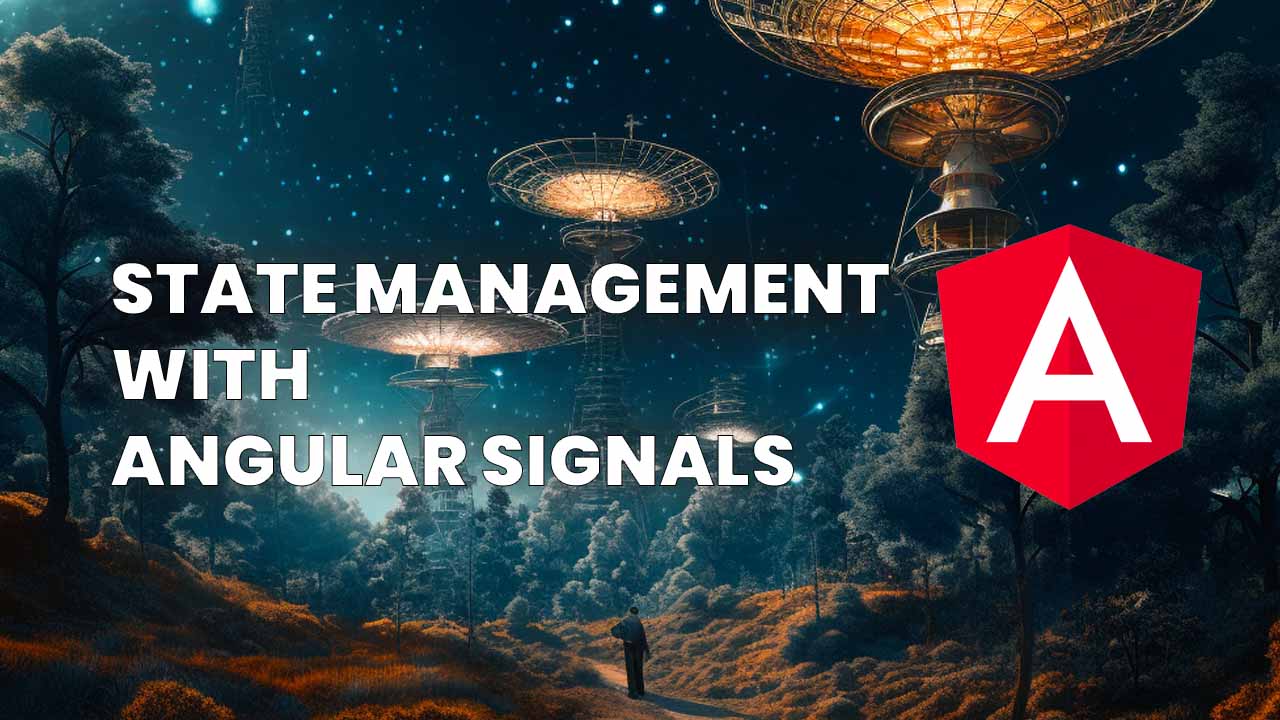State management with Angular Signals

Update July 2024: For the latest and greatest on state management, please check this article: Modern Angular State Management with Signals
Some history
I have been focused on making Angular State Management easier and developer friendly for years now. Some of the problems I was trying to fix were:
- Maintaining consistency
- Avoiding boilerplate code
- Avoiding complexity
- Avoiding dependency hell between all different kinds of states
- Avoiding learning all the ins and outs of RxJS (Subjects, Schedulers, Multicasting, Error handling, …)
- Dealing with colleagues their RxJS code or code that I had written myself 6 months ago
A while ago I published an article about Angular State Management Best Practices that can be wrapped up in:
- Keep it simple, stupid.
- Don’t manage state you shouldn’t manage.
- Keep your state as low as possible.
- Keep state synchronous.
- Always provide snapshots.
- Always provide the initial state.
- Use immutable data structures.
The first thing that we did was stop using state management frameworks to avoid boilerplate and complexity. We created Angular Injectable Services instead that used BehaviorSubjects behind the scenes because:
- They are reactive.
- They have an initial value.
- We can combine pieces of state with
combineLatest()and create standalone state instances that were state management framework agnostic. - We could provide these instances on any component level, but also as a singleton with
provideIn: 'root'. - It was simply a lot less code to write and maintain.
We didn’t have to write actions, action types, reducers, selectors, effects and more importantly, we didn’t have to maintain them.
This being said the BehaviorSubject service approach had some downsides too:
- They were brittle and unopinionated.
- We had to know RxJS extremely well.
- We had to worry about multicasting.
- We had to worry about unsubscribing from observables to avoid memory leaks.
- When using
combineLatest()the observable could be triggered multiple times in one change-detection cycle if their source observables emitted at the same time. - Snapshots were only available in BehaviorSubjects, not in the calculated state.
- We couldn’t patch multiple BehaviorSubjects in one go.
ObservableState
To fix all these problems we created ObservableState. ObservableState is a <100 lines of code class that does not contain any complexity but solves a lot of issues for us:
- It abstracts RxJS complexity away.
- It unsubscribes for us.
- It handles multicasting for us.
- It exposes our state as an Observable.
- It exposes a snapshot of our state.
- It’s completely typesafe.
- We can just connect multiple observables at the same time with a
connect()method. Takes care of multicasting, unsubscribing, etc… - It can be used for component state and global state.
- It’s tiny and easy to understand.
- we can still combine it with RxJS as much as we want.
- It’s junior-friendly.
- We can provide it on every level of the dependency injection tree.
- It’s easy to create ViewModels from them.
Behind the scenes, ObservableState is a BehaviorSubject on steroids that makes state management in Angular much easier. You can copy-paste it in your project, the code is easy to understand/maintain and you can adapt the code as you like, without having to rely on third-party state management frameworks that could make your application more complex.
The core principles of ObservableState are:
- You always need to initialize your state with default values.
- The state should be synchronous.
- The state should be reactive but also provide a snapshot.
- We should be able to calculate state by other calculated state.
- Every ObservableState instance that uses the state from another ObservableState instance should listen to it and copy that state inside the local state.
To find a complete API explanation of ObservableState, check out this article
Signals
There is no way around it, Signals are coming and some benefits are:
- They have better Change Detection.
- KISS!
- They are synchronous.
- They are glitch-free.
- They need initial data.
- We can read the value at all times (snapshot).
- Easy to create ViewModels from.
Creating a ViewModel from signal states is easy as pie:
vm = computed(() => {
return {
foo: this.foo(),
bar: this.bar(),
baz: this.baz(),
res: this.res()
}
})
Read this article if you want to prepare for Angular Signals.
Using ObservableState will actually prepare us for Signals. We are using it at our customer DHL Express aviation in different projects and it not only boosted productivity and DX, but it also followed the main principles of Signals:
- KISS
- Synchronous
- Initial data
- Snapshots
- Easy to extract ViewModels from.
Refactoring a ViewModel from an observable to a signal is as easy as this:
<!-- Observables !-->
<ng-container *ngIf="vm$|async as vm">
{{vmm.foo}}
{{vmm.bar}}
{{vmm.baz}}
{{vmm.res}}
</ng-container>
<!-- Signals !-->
<ng-container *ngIf="vm() as vm">
{{vmm.foo}}
{{vmm.bar}}
{{vmm.baz}}
{{vmm.res}}
</ng-container>
As we can see we just have to replace the $|async with ().
Signals could be seen as simplified BehaviorSubjects that are baked into the framework but that doesn’t mean we don’t need opinionated state management anymore.
Angular Signal store
Since ObservableState is fixing the problems of today but not the ones from the future we decided to implement a signal state. A simple signal store that is opinionated and looks very similar to the ObservableState. The difference is, it does not have a dependency on RxJS and it uses the new Angular signals to the fullest. Why not just use Signals, you say? While we can go a long way with using Signals in our components and creating Injectable services with signals it’s not a complete solution for State Management in Angular.
Components with functionality always contain some state, whether it is a few simple properties or some reactive objects like observables or signals, they always contain some state that will change over time. For that reason, we are firm believers that Every component should be treated as a state machine! Whether you use ObservableState, @ngrx/component-store or rx-angular, we believe treating our components as state machines is a healty mindset.
Since the patterns of ObservableState really shined in our recent DHL projects and it turns our components into state machines, we decided to create a Signal Store. SignalStore doesn’t use a single BehaviorSubject behind the scenes but it used multiple signals. Every piece of state has its signal behind the scenes. This is a decision we did not take lightly and we choose to have multiple signals because we have a lot of calculated state that can be calculated based on another piece of state that is again calculated. Having one signal introduced too many issues, so we kept it as multiple Signals.
How do we use it?
Creating the state type
Since we aim for type-safety and want a neat overview of what our state holds, we still create our state types like this (We even pick from a global state here):
type StarshipFinderComponentState = {
numberOfPassengers: number;
starships: any[];
counter: number;
loading: boolean;
filteredStarships: any[];
}
// pick 2 pieces of state from a global state
& Pick<ModelsState, 'models' | 'query'>;
Turning our components into a state machine
To use the signal store on a component, instead of doing:
export class StarshipFinderComponent extends ObservableState<StarshipFinderComponentState> {
...
}
We can now do:
export class StarshipFinderComponent extends SignalStore<StarshipFinderComponentState> {
...
}
Initializing the state
Just like with ObservableState, initializing the state can be done in the constructor:
export class StarshipFinderComponent extends SignalStore<StarshipFinderComponentState> {
// Inject some global SignalStore
private readonly modelsSignalStore = inject(modelsSignalStore);
constructor() {
super();
// Take some default state from a global SignalStore
const { query, models } = this.modelsSignalStore.snapshot;
// Initialize the state with the destructured props
// of the global state and some default values
this.initialize({
query,
models,
numberOfPassengers: 100000,
starships: [],
loading: true,
filteredStarships: [],
counter: 0,
});
}
}
Creating a ViewModel
ViewModels are reactive objects tailored for the template of our components.
Creating a ViewModel becomes a breeze too, we can use the selectMany() method to take the pieces of state that we want to read.
This will return a signal with the properties that we are interested in.
public readonly vm = this.selectMany([
'loading',
'filteredStarships',
'numberOfPassengers',
'models',
'counter',
]);
Because of the fact that SignalStore is very type-safe, the vm object will only expose the keys that are passed in the array of the selectmany() method. This results in better DX.
If our ViewModel is more complex we can pass a mapping function to the selectMany() method:
public readonly vm = this.selectMany([
'loading',
'filteredStarships',
'numberOfPassengers',
'models',
'counter',
], ({loading, filteredStarships, numberOfPassengers, models, counter}) => {
// add some calculation logic here
return {...}
});
RxJS interoperability and calculating state
RxJS interoperability, calculating derived pieces of state becomes easy as well:
const starships = toSignal(
toObservable(this.select('query')).pipe(
// sometimes we still need RxJS
debounceTime(200),
switchMap((query) => this.fetchData(query))
),
{ initialValue: [] }
);
const filteredStarships = this.selectMany(
['starships', 'numberOfPassengers'],
({ starships, numberOfPassengers }) =>
this.filterByPassengers(starships, numberOfPassengers)
);
The starships signal is based on the query signal here and does some RxJS logic because we need to debounce and perform an XHR call.
the filtererdStarships signal is dependent on the freshly calculated starships signal but it also depends on the numberOfPassengers signal.
Update: ngx-signal-state now has a connectObservables method Check it out! ngx-signal-state
Connecting signals to the store
This is one of the biggest advantages of not having a huge amount of uncontrolled signals laying around. We want to connect an object with Signals so our store gets fed automatically.
Instead of using the connect() method of ObservableState to connect observables, we now can use the connect() method to connect signals, like the ones we just calculated now:
this.connect({
starships,
filteredStarships,
});
We can even pick pieces of state from another signal store so our local state machine listens to them automatically.
For that we can use a pick() method. This returns an object that contains signals for every piece of state it wants to listen to.
this.connect({
// listen to the state of modelsSignalStore
// and push the values of query and models into the localstate
...this.modelsSignalStore.pick(['query', 'models']),
starships,
filteredStarships,
});
Patching state and using snapshots
Just like with ObservableState we can use the patch() method to patch multiple properties:
public changeQuery(query: string): void {
this.patch({ loading: true, query: string });
}
This is cleaner than manually patching a bunch of different signals here.
Getting an overview of the entire state can be easily done by using the snapshot property:
if(this.snapshot.query = ''){
this.patch({query: 'foo'})
}
There is also a reactive state signal. We can use this Angular effect that will log the state every time a property in the state changes.
effect(() => {
console.log(this.state())
})
The implementation
We have created an open-source npm package called ngx-signal-state that can you can use in all your Angular projects
The app
The app can be found here so you can already play with it.
Follow @TwitterDevJoin the club and get notified with new content
Get notified about our future blog articles by subscribing with the button below.
We won't send spam, unsubscribe whenever you want.

Update cookies preferences

 Written by
Written by